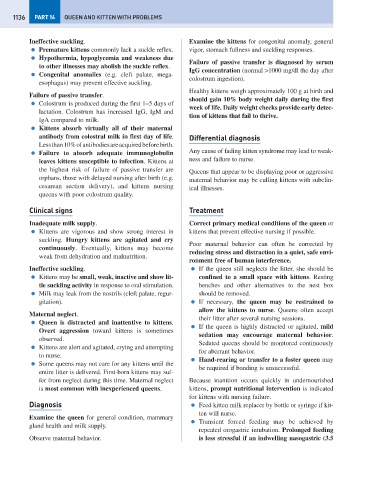Page 1144 - Problem-Based Feline Medicine
P. 1144
1136 PART 14 QUEEN AND KITTEN WITH PROBLEMS
Ineffective suckling. Examine the kittens for congenital anomaly, general
● Premature kittens commonly lack a suckle reflex. vigor, stomach fullness and suckling responses.
● Hypothermia, hypoglycemia and weakness due
Failure of passive transfer is diagnosed by serum
to other illnesses may abolish the suckle reflex.
IgG concentration (normal >1000 mg/dl the day after
● Congenital anomalies (e.g. cleft palate, mega-
colostrum ingestion).
esophagus) may prevent effective suckling.
Healthy kittens weigh approximately 100 g at birth and
Failure of passive transfer.
should gain 10% body weight daily during the first
● Colostrum is produced during the first 1–5 days of
week of life. Daily weight checks provide early detec-
lactation. Colostrum has increased IgG, IgM and
tion of kittens that fail to thrive.
IgA compared to milk.
● Kittens absorb virtually all of their maternal
antibody from colostral milk in first day of life. Differential diagnosis
Less than 10% of antibodies are acquired before birth.
● Failure to absorb adequate immunoglobulin Any cause of fading kitten syndrome may lead to weak-
leaves kittens susceptible to infection. Kittens at ness and failure to nurse.
the highest risk of failure of passive transfer are Queens that appear to be displaying poor or aggressive
orphans, those with delayed nursing after birth (e.g. maternal behavior may be culling kittens with subclin-
cesarean section delivery), and kittens nursing ical illnesses.
queens with poor colostrum quality.
Clinical signs Treatment
Inadequate milk supply. Correct primary medical conditions of the queen or
● Kittens are vigorous and show strong interest in kittens that prevent effective nursing if possible.
suckling. Hungry kittens are agitated and cry
Poor maternal behavior can often be corrected by
continuously. Eventually, kittens may become
reducing stress and distraction in a quiet, safe envi-
weak from dehydration and malnutrition.
ronment free of human interference.
Ineffective suckling. ● If the queen still neglects the litter, she should be
● Kittens may be small, weak, inactive and show lit- confined to a small space with kittens. Resting
tle suckling activity in response to oral stimulation. benches and other alternatives to the nest box
● Milk may leak from the nostrils (cleft palate, regur- should be removed.
gitation). ● If necessary, the queen may be restrained to
allow the kittens to nurse. Queens often accept
Maternal neglect.
their litter after several nursing sessions.
● Queen is distracted and inattentive to kittens.
● If the queen is highly distracted or agitated, mild
Overt aggression toward kittens is sometimes
sedation may encourage maternal behavior.
observed.
Sedated queens should be monitored continuously
● Kittens are alert and agitated, crying and attempting
for aberrant behavior.
to nurse.
● Hand-rearing or transfer to a foster queen may
● Some queens may not care for any kittens until the
be required if bonding is unsuccessful.
entire litter is delivered. First-born kittens may suf-
fer from neglect during this time. Maternal neglect Because inanition occurs quickly in undernourished
is most common with inexperienced queens. kittens, prompt nutritional intervention is indicated
for kittens with nursing failure.
Diagnosis ● Feed kitten milk replacer by bottle or syringe if kit-
ten will nurse.
Examine the queen for general condition, mammary
● Transient forced feeding may be achieved by
gland health and milk supply.
repeated orogastric intubation. Prolonged feeding
Observe maternal behavior. is less stressful if an indwelling nasogastric (3.5

